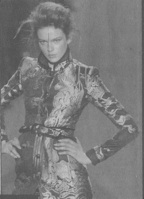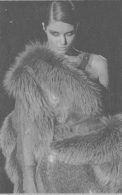Good-Bye, Gucci
By Jon Scott Blanthorn

The only guarantee in fashion is that nothing stays the same. Change is the life-giving thump at the heart of the business; the new is now. Yet even the stalwarts were agog when Tom Ford announced in November he would be leaving Gucci after a decade as creative director of the most recognizable and influential house in fashion.
So on Feb. 25 there was a mix of anticipation and tears as the fashion pack clamoured to see his glittery glorious farewell collection at the Diana Hotel in Milan. It left no doubt that the rebirth of a fading leather goods company was all Ford's doing and that his legacy should outlive most in this fickle industry.

His fall 2oo4 show was a veritable capsule of Ford's career at Gucci - slick, confident and sexual. "Tom Ford understood the international sex appeal of fashion like no one else," says Kristina O'Neill, fashion features editor at Harper's Bazaar. "He made his customers crave fashion the way they crave sex."
For menswear it was easy-going elegance with hints of '40s Hollywood glamour. Womenswear included slinky cocktail dresses, short fur jackets, understated trenches and exaggerated shoulders accentuating cinched waists. Decorative gold clasps recalled the moment Ford found fame. "This was quintessential Tom Ford for Gucci. He didn't let you down," said Robert Burke, fashion director at Bergdorf Goodman.
Ford strode down the fur-carpeted runway amid white rose petals and to the tune of Ultra Nate's anthem Free. The song coincided with his feelings. According to reports, Ford left the after-party in Milan on a Gulfstream jet and headed for Hollywood to put the finishing touches on Oscar stars' outfits, a fitting exit for the man who lived the jet-set lifestyle he sold.
Yet, he leaves a job that to most would have seemed insurmountable. With a mixture of business and marketing savvy an eye for high and low art and a fastidious design sensibility Ford and business partner Domenico De Sole endowed a sagging company with unprecedented multimillion dollar sales. Even in the current volatile market, which has seen many of the big houses cut back product and lavish shows, Gucci has seen a 12 per-cent increase in revenue - one of the highest profit levels in the industry - and continues to expand retail locations worldwide.
The road to global success was fairly quick for Ford. The native Texan moved to New York in his teens, eventually studying architecture. "I went to architecture school because I was crazy about buildings," he told New York magazine. "Then I began to realize that I got more excited about Vogue coming out each month than I was about my projects." So, in 1986 he shifted to fashion design and after stints at Cathy Hardwick and Perry Ellis, his talent and vision got him appointed womenswear designer at Gucci in 1990. In four years, he was made creative director - the Pope's role in the church of fashion.
Ford oversaw and designed the image of the Gucci brand for the Gucci Group, which no longer includes the Gucci family but is operated by Pinault-Printemps-Redoute (PPR). He was responsible for all aspects of collections design, communication and advertising store interiors and scents. In 2000 PPR bought the Yves Saint Laurent label for which Ford took on the same creative leadership responsibilities.
That year the Gucci Group also brought into the fold cutting edge designers Alexander McQueen, Stella McCartney and Balenciaga, leather goods brand Bottega Veneta, the jewelry emporium Boucheron, and shoe designer Sergio Rossi. The purchases increased its profile as one of the biggest luxury fashion corporations in the world (rivaled only by Louis Vuitton Moet Hennessy) and solidified the power of the Gucci name. None would have been possible without Ford's input.
With the Gucci Group, Ford's ability to bridge fashion's dichotomy of giving people what they wanted while maintaining exclusivity made him a master of luxury branding. "His entire esthetic could be distilled into a glamorous, sellable product whether it was a logo covered beach ball, a dog bed, or a drop dead glamorous evening gown," says O'Neill.

This reestablishment of the importance of the logo for a recognizable brand was essential. "Ford put the double G back onto handbags, sunglasses, jewelry and shoes, reintroducing Gucci to visual culture. You could walk into any store in the world and purchase a piece of the Gucci lifestyle," says O'Neill.
There were few mixed messages in the designs, no hidden meanings. "He embraced sex and all of its high heeled guises while brilliantly marketing his glamorous idealization of women, whether it was a steel spike on a stiletto to a jeweled thong to a dress with a slice just at the hip bone", says O'Neill. These were high glamour clothes for internationalists and people who wanted to be like them. Ford targeted an audience that embodied sexual confidence, mixing high gloss with a distinctive shape.
"Tom Ford's biggest contribution to fashion was a silhouette, that low on the hip slightly flared trouser worn with a skinny sexy shirt," says Ceri Marsh editor of Fashion magazine "As well as being a flattering shape that gives the appearance of longer legs, the Gucci look also had a sexy yet androgynous appeal that women responded to."
Perhaps his most enduring bequest is the image he projected of himself. With a cool, calm demeanor, short hair, shirt suggestively unbuttoned paired with jeans and tailored jacket, he exuded charm and intelligence. "The way Ford changed the industry was even greater than his effect on fashion itself," says Marsh "He brought back a fascination with designers as stars Gucci was Tom Ford. You knew that he had a hand in everything they did … He gave a washed-up label a new life."
Collections were named "Tom Ford for Gucci," prompting suggestions it was the elevation of his name above the label that made PPR uncomfortable. Following failed contract negotiations with the company in November, Ford and De Sole will leave in April. It was reported that the two were actually forced out by company heads uneasy with their domination. On March 11, Ford's replacement was announced - a team of designers already with the company and undoubtedly familiar with the image he cultivated.
Front-row rumours abound as to what role Ford will take on next: TV host, singer, actor, designer at a rival house? For certain, he has signed a deal with Creative Artist Agency. "I am very serious about wanting to make a movie as a director," he told Women's Wear Daily. "I am actively looking for a project."
Regardless if he goes Hollywood or not, there is no mistaking the Tom Ford legacy.
"I asked myself what was my Gucci all about?" he told the International Herald Tribune after his show in Milan. "It's about celebrating a playboy, about hedonism, luxury, glamour and sex. I've always been in love with all those things."
Jon Scott Blanthorn is a Toronto writer.

